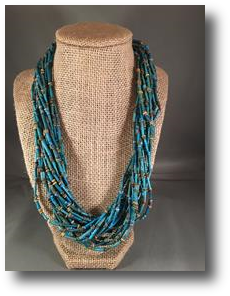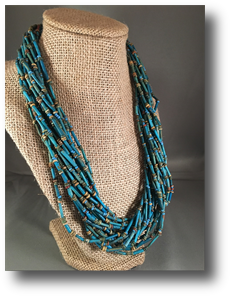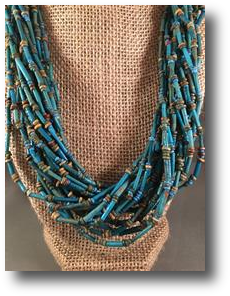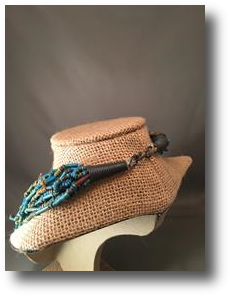EGYPTIAN JEWELRY

Item #AB1044
19 Strand Egyptian FaienceNecklace Late Dynastic Period
CA 1085-525 BCE
19 Strand Egyptian FaienceNecklace Late Dynastic Period
CA 1085-525 BCE
AB1044; Late Dynastic Period, CA 1085-525 BCE $2,100
These ancient Faience beads date from Egypt’s Late Dynastic Period, approximately the 21st to 26th Dynasties. They are a combination of tubular beads, mostly in lush turquoise colors with disc beads in multiple hues. This necklace is comprised of 18 strands strung together to create a stunning visual impression. They have been strung for wearing, to a length of about 19 inches, excluding the 3 inch clasp, using modern materials and sterling clasp, which will be polished before delivery unless otherwide desired by purchaser. This is a magnificent and impressive piece to be sure, with almost 370 inches of top quality ancient beads. Guaranteed ancient as described.
Faience Faience, a ceramic formed from a mixture of sand and quartz with additives for color, is considered to be the forerunner of true glass. It was used to produce beads for jewelry, as well as votive and utilitarian items. During firing, the added impurities migrated to the surface, creating the durable glaze and producing the beautiful colors it is so prized for. Large amounts of faience items were produced for funerary use as well, to accompany the departed into the afterlife. The greatest number of Egyptian beads were made of Faience, an inexpensive alternative to the precious stones they emulated, such as turquoise and Lapis. Possibly invented in either Mesopotamia or Egypt, by 4000 BCE, Faience was the first mass produced synthetic material to simulate precious stones. The development of Faience, and eventually glass, satisfied the desire of the general populace to wear beads that emulated the precious stones of the wealthy.
These ancient Faience beads date from Egypt’s Late Dynastic Period, approximately the 21st to 26th Dynasties. They are a combination of tubular beads, mostly in lush turquoise colors with disc beads in multiple hues. This necklace is comprised of 18 strands strung together to create a stunning visual impression. They have been strung for wearing, to a length of about 19 inches, excluding the 3 inch clasp, using modern materials and sterling clasp, which will be polished before delivery unless otherwide desired by purchaser. This is a magnificent and impressive piece to be sure, with almost 370 inches of top quality ancient beads. Guaranteed ancient as described.
Faience Faience, a ceramic formed from a mixture of sand and quartz with additives for color, is considered to be the forerunner of true glass. It was used to produce beads for jewelry, as well as votive and utilitarian items. During firing, the added impurities migrated to the surface, creating the durable glaze and producing the beautiful colors it is so prized for. Large amounts of faience items were produced for funerary use as well, to accompany the departed into the afterlife. The greatest number of Egyptian beads were made of Faience, an inexpensive alternative to the precious stones they emulated, such as turquoise and Lapis. Possibly invented in either Mesopotamia or Egypt, by 4000 BCE, Faience was the first mass produced synthetic material to simulate precious stones. The development of Faience, and eventually glass, satisfied the desire of the general populace to wear beads that emulated the precious stones of the wealthy.
Click Image to Enlarge













